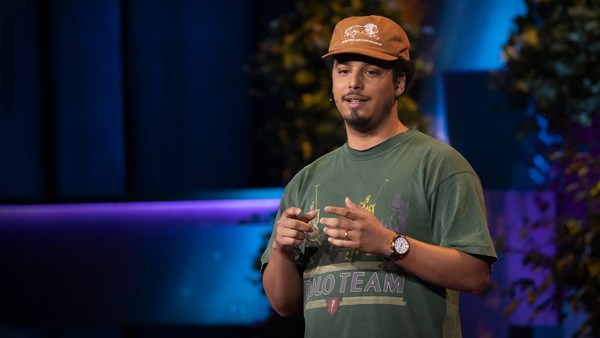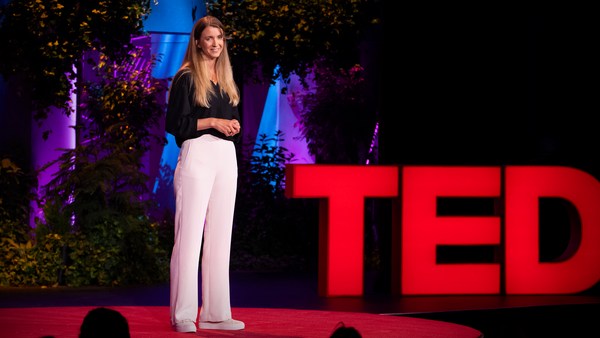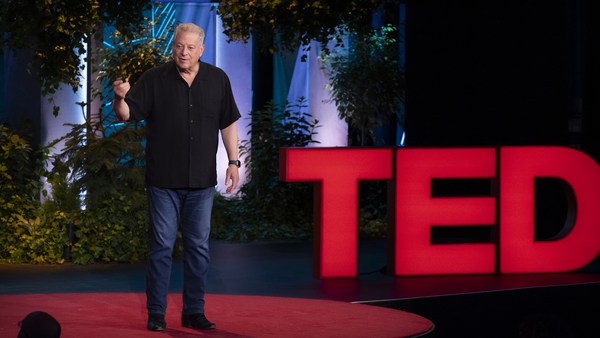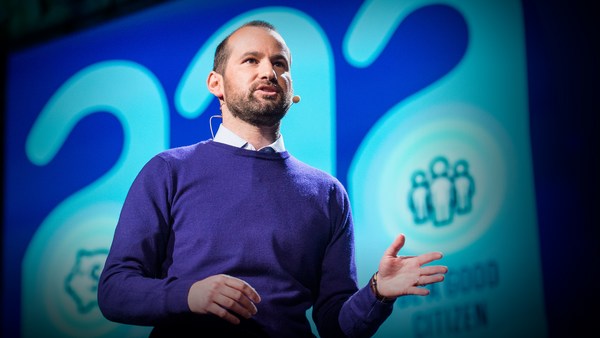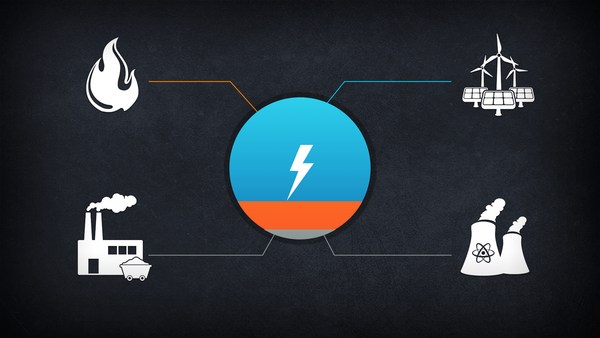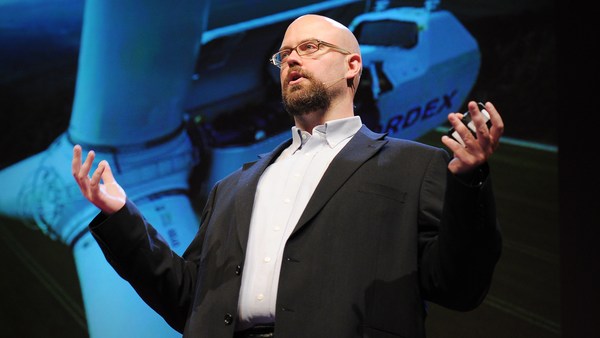So my wife and I have two young children. And like many of you, we are terrified about what the worst impacts of the climate crisis are going to be for them in their lives. Do we honestly have a plan that's specific that's achievable, that's actionable, that's going to allow us to reduce emissions at scale with the speed that's necessary to respond to the catastrophe in time to improve the quality of life for our kids?
We've decided to focus and devote our time and attention to the challenge of greening buildings in America. And I'll tell you a little bit about why.
There are 125 million buildings in America, coast to coast. These buildings are where we cook and eat and work and pray and raise our kids. A lot of us spend almost 90 percent of our time indoors in buildings, and these buildings are powered by fossil fuels. We burn coal and gas at power plants, we burn oil and gas in buildings. This is a furnace that produces hot water and heating. This is in an apartment complex in Harlem that we visited back in 2014. And I remember visiting it, I was a little worried because we could smell gas kind of, leaking. And a few blocks away, a few weeks before this visit, an apartment building had a gas furnace that exploded. It collapsed the entire apartment building, it collapsed the apartment building next door, and eight people died. So I remember looking at this boiler and taking a picture and thinking, “Get me the heck out of here.”
(Laughter)
So because fossil fuels power our 125 million buildings, it's 30 percent of emissions, 30 percent of American emissions are tied to our buildings. And there is no actionable path to responding to the climate crisis without going building by building and greening all of the existing buildings in America.
So I'm Donnel Baird, I'm the CEO of BlocPower. We are a technology company that focuses on moving buildings off of fossil fuels. We want to make buildings smarter, healthier, greener, and we want to do that by making buildings 100-percent electric. We're here in Detroit. Detroit is learning how to rip fossil fuel engines out of vehicles and replacing them with smarter, all-electric engines. We want to do the same thing for buildings. We want to rip out all the fossil fuel equipment and replace it with smart, green, all-electric equipment. And we want that equipment to be powered by electricity that’s clean. Stanford professor Mark Jacobson has written a plan for all 50 states to be powered by wind, by hydroelectric power, by solar, state by state, so that our entire grid can be clean.
I got focused on the dangers, the perils of fossil fuel systems. Growing up as a kid with my family in a one-bedroom apartment in Brooklyn, we didn't have a heating system that worked in our apartment building in Brooklyn. So when it got really cold in the winters, my parents, sometimes they worked nights, they would tell me, "Look, if it gets too cold, light a match, turn on the gas oven, open up the oven door, and don't forget to open up a window because heat's going to come into the apartment, but so is carbon monoxide, and we don't want you to suffocate." Then they'd go to work. And millions of Americans across the country heat their buildings this way in the winter and worse.
But it's not just the low-income buildings that are super dangerous with fossil fuel infrastructure. Recent studies indicate that gas ovens, gas heating systems in our home leak benzene, they leak methane, they leak nitrogen dioxide. There's so much nitrogen dioxide emitted into American homes that it causes about 13 percent of chronic childhood asthma. There's so much methane leaked into our homes that it's equal to the emissions of 500,000 gas-powered vehicles. And benzene, benzene is a carcinogen. And the latest studies from Stanford indicate that benzene is emitted into our homes, it spreads throughout the home, it lingers, we breathe it in. And it actually can be worse than breathing in secondhand cigarette smoke. And so for any parent, the thought of our children sleeping and breathing all this stuff in, it's horrific.
But good news, it's 2023. We don't live in ancient Mesopotamia. We no longer have to dig up dead dinosaurs from the ground and burn them in our buildings for energy. We've got options. This is an electric induction oven that uses electricity and induction power of magnets. It’s hyper-efficient, it’s safe. The finest chefs in the world are starting to use these ovens and systems. They can boil hot water in less than 60 seconds. Pretty awesome. And one of the new technologies that I'm really excited about is the cold climate heat pump. Cold climate heat pumps are like a silver bullet for reducing emissions in buildings. We can now do things that we could not do five years ago because of this technology. They use electricity and refrigerant and compressors to pump hot air into your home in the winter, to pump hot air out of your home during the summer, to heat up hot water. But most importantly, it allows us to fundamentally unhook buildings from fossil fuels. We can unplug all of our buildings and homes from fossil fuels entirely due to these systems.
So let's go back to my building in Brooklyn. We now have a mix of technologies that we can install in our building: solar panels on the roof, high-efficiency lighting, electric hot water heating systems, electric heat pumps for heating and cooling, the electric oven. We can make these buildings all electric. If we're in Detroit or LA or in Houston, one of the cities where people love their cars, we'll of course, install some electric-vehicle charging stations. We'll have some backup battery systems because all three electricity and energy grids are collapsing under the weight of heat waves and the climate crisis. But we can electrify buildings.
Now, is it simple? Is it easy to electrify buildings? No, there's challenges and opportunities. We have to solve the finance problem, we have to solve a workforce problem, we have to solve a data problem. Electrification can cost 10, 20, 30,000 dollars per building. And that's not affordable for the average American. But what we can do is most Americans can afford to buy a home on their own. And so we have a mortgage. And so we studied the mortgage market and found ways to amortize and spread out the upfront cost of building electrification over 15 years so that the monthly payment is affordable and lower in some instances than what families pay for fossil fuels.
We have a workforce problem in that, like Europe, there's a shortage of skilled electricians and technicians across America to deliver on these projects. Mayor Eric Adams in New York City has asked us to train and hire 3,000 vulnerable and low-income individuals, ex-offenders, gang members, military veterans with PTSD, formerly homeless folks, to train them in building electrification. We had a gang, a street gang kind of come to us and say, "Look, if you guys hire us and give us jobs, we will shut down our street gang." We had a crew of workers who had been locked up in Rikers Island, our New York City jail, and we trained them, we hired them, we took them back to Rikers Island, They installed solar panels in the parking lot.
We have a data problem. Every building is unique, like a snowflake. So in order to make sure we have the right size of the electrification equipment for that building, to unhook it from fossil fuels, we have to collect data and make sure we specify and recommend the right equipment. We've been working with the Bezos Earth Fund to aggregate all of the data on all 125 million buildings across America so that families can search for their address, get an electrification work plan, hand it to a local, well-trained electrician who we've trained and hired. These are good jobs that can't be outsourced, so that every family has access to the data that they need. We've recently started working with Ithaca, New York, where Cornell is located, and San Jose and Menlo Park. These are cities that have committed to decarbonize 100 percent by the year 2030, in six and a half years. So we're going to go building to building and move each building off of fossil fuels and make them all-electric. So we've got six and a half years, but there's dozens of cities across the country where we're working with partners: Portland, Oregon, Denver, Atlanta, Chicago to electrify buildings at scale.
Electrification is possible. It's not simple, it's not easy, but it is possible. And what that means is if we can electrify one building, it means that we can electrify a whole block of buildings. If we can electrify a block of buildings, it means that we can electrify a neighborhood. If we can electrify a neighborhood, it means that we can electrify a city. And if we can electrify a city, that means we can electrify a country.
There’s a saying: you have to be the change that you wish to see in the world. By doing this, we’re going to create great jobs. There’s going to be massive economic and public health outcomes. But we also are going to inspire cities and countries around the world to electrify. And we’ll be able to look our children in the eyes when they ask us and say that we're doing everything we can to reduce emissions at speed and scale, to fight the most damaging impacts of the climate catastrophe.
Thank you.
(Applause)
